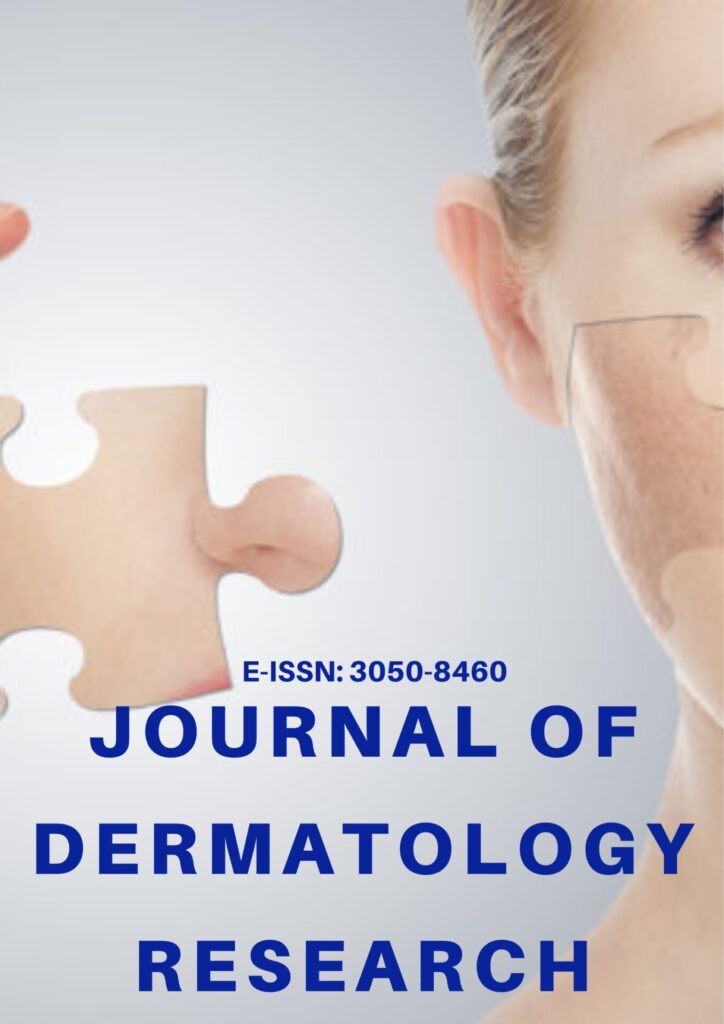Review Article | Vol. 6, Issue 1 | Journal of Dermatology Research | Open Access |
Psychodermatoses: Diagnostic and Therapeutic Challenges
Maria Novosartyan1*, Hovhannes Hovhannisyan2
1First Moscow State Medical University named after I.M. Sechenov, Russia
2National Center for Burns and Dermatology of MOH of RA, Russia
*Correspondence author: Maria Novosartyan, First Moscow State Medical University named after I.M. Sechenov, Russia; Email: marianovosartyan@gmail.com
Citation: Novosartyan M, et al. Psychodermatoses: Diagnostic and Therapeutic Challenges. J Dermatol Res. 2025;6(1):1-10.
Copyright© 2025 by Novosartyan M, et al. All rights reserved. This is an open access article distributed under the terms of the Creative Commons Attribution License, which permits unrestricted use, distribution, and reproduction in any medium, provided the original author and source are credited.
| Received 31 December, 2024 | Accepted 19 January, 2025 | Published 26 January, 2025 |
Abstract
A complicated subgroup of psychodermatological conditions is self-induced dermatoses, which affect not only the skin but also its appendages (hair and nails). These conditions occur when people harm themselves due to underlying mental health issues. These disorders include Dermatitis Artefacta, Delusional Parasitosis, Trichotillomania, Onychotillomania and Excoriation Disorder, where patients simulate or create skin lesions. Often, there is no underlying organic skin disease and the patient’s denial of self-harm further complicates diagnosis and treatment. This article explores the clinical manifestations of self-induced dermatoses, the diagnostic difficulties they present and the essential role of both dermatologists and psychiatrists in managing these conditions. Recognizing the psychological factors behind these behaviors are vital for creating comprehensive treatment strategies that combine both medical and psychiatric care. Early diagnosis and collaboration between dermatologists and psychiatrists are fundamental to enhancing patient outcomes and reducing the risks of severe consequences, such as self-harm and suicide. Additionally, the article discusses emerging therapeutic approaches and cultural perspectives to ensure a global and forward-thinking understanding of psychodermatoses.
Keywords: Psychodermatoses; Delusional Parasitosis; Trichotillomania; Dermatitis Artefacta; Excoriation
Introduction
Self-induced dermatoses are a collection of artificial skin injuries and appendages that result from a patient’s self-injury to either eliminate unpleasant emotions and sensations or to simulate a well-known dermatitis due to a pathological desire for hospitalization to satisfy emotional or financial needs [1].
Most psychodermatological disorders can be divided into four main groups:
- Primary psychiatric disorders, where no actual skin disease is present and all symptoms are self-induced or imagined
- Psychophysiological (psychosomatic disorders), where a specific dermatological condition is exacerbated by emotional stress and unresolved emotional problems manifest as physical, somatic symptoms;
- Cutaneous sensory disorders, where the patient experiences abnormal sensations on the skin without any dermatological lesions
- Secondary psychiatric disorders, where the patient develops emotional difficulties due to the perception of a serious physical defect [2,3]
Clinical cases in which no true skin disease is present and no objective symptoms align with the patient’s concerns regarding their skin condition are classified as primary psychiatric disorders. In such cases, all abnormal symptoms are self-inflicted. These include self-induced dermatitis, delusional parasitosis, trichotillomania, onychotillomania and neurotic excoriations [4].
A variety of psychopathological problems may manifest in patients with these conditions. Obsessive-compulsive, depressive, delusional and generalized anxiety disorders are typically seen [5].
Typically, patients with psychogenic dermatoses initially seek consultation with a dermatologist. However, they are referred to a psychiatrist when their skin self-injury occurs in the context of severe mental disorders. In most cases, patients hide their self-destructive actions or provide false information about the origin of their skin lesions, which creates significant diagnostic challenges for dermatologists. Additionally, conflicts often arise between the doctor and the patient or their family members, as the family may disagree with the conclusion that there is no underlying dermatological pathology. A well-structured conversation is the primary approach to investigating the nature of the skin damage [6].
The presentation and prevalence of psychodermatoses vary widely across cultural and regional contexts. For example, delusional parasitosis in Western countries often involves clinical presentations influenced by biomedical explanations, whereas in tropical regions, cultural beliefs about “spiritual infestations” or “hexes” may influence symptom descriptions and help-seeking behaviors. Additionally, socio-economic factors and access to healthcare play crucial roles. In resource-limited settings, the lack of psychiatric support can delay proper diagnosis and treatment, exacerbating the condition [7].
Studies highlight that cultural perceptions of mental health significantly affect patient behavior and treatment adherence. For example, in some Asian cultures, individuals may somatize psychological distress, presenting with unexplained physical symptoms, including skin conditions [8]. Conversely, in Western societies, greater awareness of mental health disorders might lead to earlier psychiatric referrals but could also increase stigma associated with psychogenic conditions. For instance, studies have found that while psychiatric awareness facilitates referrals, cultural attitudes towards mental illness often result in patients concealing symptoms for fear of social judgment or professional consequences [9].
Recognizing and addressing these disparities is essential for tailoring treatment approaches to diverse populations and ensuring equitable care. In therapy, neuroleptics, psychotropic drugs and antidepressants are additionally used to reduce the obsessive urge to inflict self-harm [10]. If self-harm is not a symptom of a severe mental disorder, Cognitive Behavioral Therapy (CBT) can be quite effective [6]. Recent advancements have also introduced emerging therapies that provide promising new options for patients. Digital mental health tools, such as mobile applications for tracking skin-picking behaviors or wearable devices for monitoring and intervention, are gaining traction. These tools offer real-time feedback and encourage self-regulation [11]. Additionally, unusual behavior, such as talking to oneself, along with a disheveled or unkempt appearance, are common indicators of underlying mental health conditions in these patients [12]. Future research into these methods could revolutionize the management of psychodermatoses, especially in cases where conventional treatments fall short. The following signs are typical for most psychodermatoses:
- Monomorphic eruptions
- Regular appearance of new eruptions
- Prevalence of secondary skin lesions
- Clearly defined borders of the affected areas with unchanged skin around them
- Linear, “proper” arrangement of the rash elements
- Absence of eruptions in hard-to-reach areas of the body
- Resistance to ongoing therapy and regular recurrence of eruptions
- A connection between the formation of eruptions and psychotraumatic factors [13]
Dermatitis Artefacta (DA)
It is a type of factitious disorder characterized by self-inflicted skin lesions that the patient usually denies causing [14]. In dermatological clinics, the frequency of DA varies from 0.04% to 1.5% [15]. The female-to-male ratio is 20:1, indicating a clear predominance among women [16,17]. Although it can be detected at any age, DA is more prevalent between 20 and 30 years of age and is rare after the age of 50-60 [18,19].
In the context of an existing mental illness, various social conflicts and psychotraumatic events often trigger the onset of the first skin lesions [20]. The lesions are often bilaterally symmetrical, easily accessible with the dominant hand and may take the form of burn scars, purpura, blisters, ulcers or bizarre shapes with sharp geometrical or angular edges (Fig. 1). There may also be edema and erythema. Lesions can be caused by the patient through biting, sucking, rubbing, scratching, picking, cutting, punching or by applying heat, caustics or dyes. Some patients inject substances such as blood or excrement [21].
Even when the skin lesions clearly show signs of artificial origin, patients consistently deny engaging in self-harm [22]. When taking the patient’s medical history, one may hear dubious stories regarding the origins of the condition. Additionally, unusual behavior, such as talking to oneself, along with an untidy, messy appearance, are common indicators of mental disorders in these patients [23].
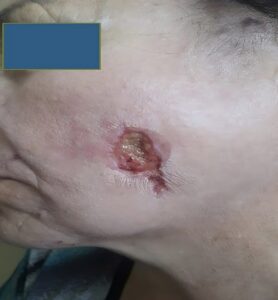
Figure 1: Dermatitis Artefacta (DA).
Delusional Parasitosis (DP)
Delusional Parasitosis (DP) is a somatic form of delusional disorder, typically monosymptomatic, in which patients believe they are infested with parasites, worms, mites, bacteria, fungi or other living organisms (Fig. 2).
Fewer than 3 cases of DP per 1000 psychiatric inpatients or 40 cases per million in the general population, are reported [24]. It is typically found in middle-aged or older women and is more common among Caucasians. For individuals under 50, the female-to-male ratio is 1:1, while for those over 50, it is 3:1 [25,26]. Additionally, women are more likely to experience longer-lasting illnesses [24].
The characteristic actions of the patient include collecting and presenting “parasites” to the doctor: pieces of hair, skin and fabric fibers, which the patient gathers in containers and presents as “evidence” (the “matchbox sign”) [27]. Many individuals with DP take various precautions due to a fear of infecting others, particularly their family members [28]. Patients inflict injuries on themselves in an attempt to eliminate the parasites. These patients often exhibit signs of burning, exposure to acids (and sometimes alkalis), disinfectant solutions and picking at the skin to destroy the “tunnels” [29].
People with DP typically experience itching, believed to be formication – a tactile hallucination that feels like insects biting and crawling on or beneath the skin. Skin lesions usually appear in easily accessible areas such as the hands, arms, feet, lower legs, scalp, upper back, breast region and genitalia, while the back and other hard-to-reach body parts remain symptom-free [28]. There may be no visible skin lesions during a physical examination. Primary skin lesions are absent. Commonly observed secondary skin lesions include excoriations, lichenification, erosions, ulcers with hemorrhagic crusts, hyperpigmentation, hypopigmentation and scars [30].
These eruptions are often associated with real primary morphological skin elements: patients may perceive any skin formations (nevi, papillomas, seborrheic keratoses) as “clusters,” “nests,” or “egg deposits” of non-existent parasites [23]. Treatment for DP presents a therapeutic challenge, as many patients refuse mental health care, believing their parasitic infestation is a real condition rather than a psychiatric condition [31]. These patients typically seek care from dermatologists. A positive doctor-patient relationship is essential for effective treatment [32]. Research has shown that treating delusion of parasitosis with antipsychotics can result in response rates ranging from 60% to 100% [33]. However, delusional disorders always carry a risk of recurrence [34].
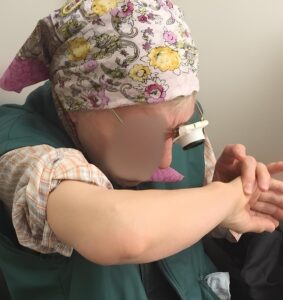
Figure 2: Delusional Parasitosis (DP).
Trichotillomania and Onychotillomania
Trichotillomania and Onychotillomania are compulsive, repetitive behaviors in which the patient engages in self-extraction (pulling out) of hair and self-destruction (self-harm) of the nail plates and surrounding tissues, respectively. Although there are few comprehensive epidemiological studies available, estimates suggest that the prevalence of this disorder in the general population is between 0.5% and 2% [35]. However, the true prevalence of trichotillomania may be higher, as some individuals feel ashamed of the condition. Trichotillomania shows a significant female predominance in adults, with a female-to-male ratio of 4:1 [36]. Some researchers note the presence of two age peaks in the manifestation of the disorder – early childhood and adolescence – although the onset of trichotillomania most often coincides with puberty. Therefore, this disorder is relevant for specialists working with both adults and those in pediatric and adolescent practice [37].
In most cases, patients do not suffer from severe mental disorders and are aware of their role in causing the damage [23]. Patients typically feel increasing tension right before engaging in hair pulling or damaging their nail plates. When they try to resist these actions, the tension grows stronger. However, after pulling their hair or harming their nails, they often experience a sense of relief and sometimes even satisfaction [38]. The onychotillomania manifests as median canaliform nail dystrophy, which results from regular, unconscious trauma to the proximal nail fold, where the growth zone is located. Constant impact on the nail matrix leads to the development of a distinctive form of onychodystrophy (Fig. 3) [23].
Most often, hair extraction occurs on the scalp (72.8-83.0%), although the eyebrows (56.4%) and pubic area (50.7%) are also frequently affected [39,40]. The bald patches often have an unusual shape, with angular or uneven edges. In some cases, alopecia on the crown is encircled by a fringe of unaffected hair, giving it a resemblance to the tonsure seen in Christian monks (known as the “Friar Tuck” sign) [35,36]. Hair strands are of varying lengths due to being broken off at different points or pulled multiple times, creating a rough texture when the scalp is touched (Fig. 4) [41].
When diagnosing trichotillomania, dermatoscopic (trichoscopic) examination helps identify characteristic symptoms of the disease: hook hairs or question mark hairs, broken hair shafts of varying lengths, flame-shaped hairs, brush-type hairs (trichoptilosis), twisted hairs and follicular hemorrhages [42].
More than 20% of patients may also experience trichophagia, where they ingest the hair they pull out, leading to the formation of trichobezoars or hairballs. These hairballs can cause serious gastrointestinal issues, often requiring surgical intervention [41, 43].
Trichotillomania is a complex and not well-understood condition that can severely impair the quality of life and disrupt the social and psychological functioning of those affected. Signs of worsening include an increase in the number of areas from which hair is pulled, more frequent urges to pull and a greater concentration on the act of pulling [44].
Activities frequently associated with hair-pulling in trichotillomania include driving, reading, working on paperwork, watching television and talking on the phone. Patients should be advised to reduce these activities when possible and increase their physical activity [45].
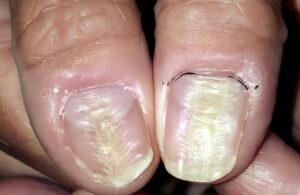
Figure 3: Onychotillomania.
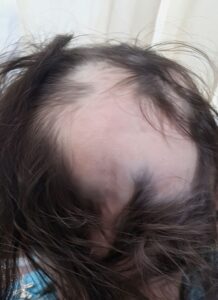
Figure 4: Trichotillomania.
Excoriation (skin-picking) Disorder
Excoriation (skin-picking) Disorder (ED), also referred to as dermatillomania, psychogenic excoriation or neurotic excoriation, is marked by the compulsive picking and scratching of otherwise healthy skin [46,47]. Skin-picking is relatively common, with prevalence rates for ED estimated to range from 1.4% to 5.4% [48]. ED can occur at any age but typically begins during adolescence, often coinciding with puberty [49]. The majority of individuals seeking treatment for ED are women, with most studies indicating an average onset between the ages of 30 and 45 [50].
Dermatological conditions like acne or eczema, along with factors such as stress, anger and anxiety, as well as sedentary activities like watching television, reading, boredom and fatigue, can trigger ED [51]. Self-harm is often preceded by a visual inspection or touching of the skin to “detect a defect” on its surface. After the self-harm phase (once all the scabs are removed), there is a temporary period of relief and inner satisfaction. However, after some time, discomfort and dissatisfaction with the skin eventually return, along with an overwhelming urge to manipulate the existing rash elements [23]. Various psychosocial consequences have also been noted, including feelings of social embarrassment, avoiding situations or activities where skin lesions might be noticed and a decrease in productivity across different environments [52].
ED is typically characterized by clean, linear erosions, along with scabs and scars that often show either hypopigmentation or hyperpigmentation. The lesions are generally uniform in size and shape. Patients tend to “dig” into their skin to relieve itching or to extract imagined objects they believe are lodged or protruding from their skin. These lesions are typically located in easily reachable areas of the body, such as the extensor surfaces of the limbs, the face and the upper back, which are often exposed [53]. The number of lesions can range from just a few to several hundred (Fig. 5) [54].
It is estimated that fewer than one in five patients seek treatment for their skin-picking behavior [55]. The reasons for not seeking help include social embarrassment, thinking of the condition as merely a “bad habit,” or believing that it cannot be treated. Those who do pursue treatment often first visit a general practitioner or dermatologist before seeing a psychiatrist or psychologist [56].
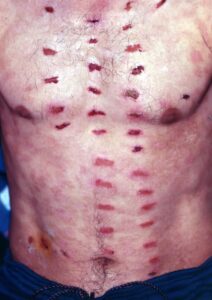
Figure 5: Excoriation (skin-picking) Disorder (ED).
Conclusion
Although skin changes related to psychogenic disorders have been undervalued in recent years and not always recognized as disorders, the rise of psychodermatology as a distinct specialty has led to an increasing number of patients requiring treatment. Despite these advancements, significant limitations in current therapeutic strategies remain. Many approaches focus on managing symptoms rather than addressing the underlying psychopathology comprehensively. Additionally, the stigma surrounding mental health issues continues to delay diagnosis and treatment. Emerging therapies, such as digital tools and habit-reversal training, though promising, require further large-scale validation studies to confirm their efficacy across diverse populations. Future research should prioritize the integration of dermatological and psychiatric interventions and explore strategies to overcome sociocultural barriers, ultimately improving outcomes and reducing the global burden of psychodermatoses. Unfortunately, dermatological conditions are often dismissed as cosmetic and their long-term psychological effects on patients are overlooked. Similarly, skin changes in psychiatric patients are rarely linked to their primary mental health condition. Therefore, collaboration between psychiatrists and dermatologists is essential, not only to provide timely treatment but also to improve the overall quality of life for these patients. Accurate diagnosis of psychodermatoses can help avoid unnecessary tests and treatments and may also reduce mortality from suicide attempts and accidents related to self-harm. Expanding therapeutic options and investing in future research are vital steps in addressing these challenges and ensuring comprehensive, equitable care for affected individuals.
Conflict of Interest
The authors declared no potential conflicts of interest with respect to the research, authorship and/or publication of this article.
Funding
This research received no specific grant from funding agencies in the public, commercial or not-for-profit sectors.
Author Contributions
Maria Novosartyan
- Developed the concept and design of the study
- Conducted the literature review
- Wrote and edited the manuscript
- Provided patient photographs for publication
Hovhannes Hovhannisyan
- Provided additional patient photographs for publication
- Reviewed and approved the final version of the paper
References
- Olisova OY, Teplyuk NP, Kayumova LN, Smirnova LM, Anpilogova EM, Nikulina AS. Self-induced dermatosis: a diagnostic problem at the intersection of two specialties. Russian J Skin and Venereal Diseases. 2021;24(1):61-70.
- Chastaing M, Misery L. Psiquiatría y dermatología. EMC-Dermatología. 2020;54(2):1-20.
- Mar K, Rivers JK. The mind body connection in dermatologic conditions: a literature review. J Cutan Med Surg. 2023;27(6):628-40.
- Zilberberg NV, Zhulimova NL, Retiunskii K, Yu, Syrneva TA, Rimar OG. Autodestructive dermatosis of the facial skin. Lechaschi Vrach. 2023;7-8(26):80-4.
- Harth W, Gieler U. Psychodermatological diseases. InBraun-Falco´ s Dermatology. Berlin, Heidelberg: Springer Berlin Heidelberg. 2021;1-15.
- Tlish MM, Gluzmin MI, Sycheva NL, Shavilova ME, Lazarev VV, Shevchenko AG. Self-Destructive Dermatosis Mimicking Pyoderma Gangrenosum: A Clinical Case. Kuban Scientific Medical Bulletin. 2022;29(6):84-95.
- Lund C, Tomlinson M, Patel V. Integration of mental health into primary care in low- and middle-income countries: The PRIME mental healthcare plans. British J Psychiatry. 2016;208(s56):s1-3.
- Zhou X, Min S, Sun J, Kim SJ, Ahn JS, Peng Y, et al. Extending a structural model of somatization to South Koreans: Cultural values, somatization tendency and the presentation of depressive symptoms. J Affective Disorders. 2015;176:151-4.
- Schomerus G, Angermeyer MC. Blind spots in stigma research? Broadening our perspective on mental illness stigma by exploring ‘what matters most’ in modern Western societies. Epidemiol Psychiatric Sciences. 2021;30:e26.
- Jafferany M, Mkhoyan R, Arora G, Sadoughifar R, Jorgaqi E, Goldust M. Treatment of skin picking disorder: Interdisciplinary role of dermatologist and psychiatrist. Dermatol. Ther. 2020;33(6):e13837.
- Gallinat C, Moessner M, Haenssle HA, Winkler JK, Backenstrass M, Bauer S. An Internet-Based Self-Help Intervention for Skin Picking (SaveMySkin): Pilot Randomized Controlled Trial. J Med Internet Res. 2019;21(9):e15011.
- Rijal R, Adarsh H, Chauhan N. Innovative strands of healing: nurturing recovery in a case of trichotillomania via tele-based habit reversal therapy. Prim Care Companion CNS Disord. 2025;27(1):24cr03785.
- Tamrazova OB, Gureeva MA. Pathomimia in children. Vestnik Dermatologii I Venerologii. 2017;93(3):76-84.
- Nagesh NM, Barlow R, Mohandas P, Gkini MA, Bewley A. Dermatitis artefacta, Clin Dermatol. 2023;41(5):10-15.
- Millard J, Millard L. Factitious skin disorder (dermatitis artefacta). In: Bewley A, Taylor RE, Reichenberg RS, Magid M, editors. Practical Psychodermatology. Oxford, UK: Wiley-Blackwell. 2014;142-9.
- Chandran V, Kurien G. Dermatitis artefacta. Treasure Island (FL): StatPearls Publishing. 2024.
- Nielsen K, Jeppesen M, Simmelsgaard L, Rasmussen M, Thestrup-Pedersen K. Self-inflicted skin diseases. A retrospective analysis of 57 patients with dermatitis artefacta seen in a dermatology department. Acta Derm Venereol. 2005;85(6):512-5.
- Rodríguez Pichardo A, García Bravo B. Dermatitis artefacta: a review. Actas Dermosifiliogr. 2013;104(10):854-66.
- Saha A, Seth J, Gorai S, Bindal A. Dermatitis artefacta: a review of five cases: a diagnostic and therapeutic challenge. Indian J Dermatol. 2015;60(6):613-5.
- Rajkumar RP. Psychiatric comorbidities in dermatitis artefacta: A systematic review and meta-analysis. CosmoDerma. 2021;1:49.
- Estill, Mariah C, Mohammad Jafferany. Treatment of dermatitis artefacta: a systematic review. European Medical J. 2024.
- Shivakumar S, Jafferany M, Kumar SV. A brief review of dermatitis artefacta and management strategies for physicians. Prim Care Companion CNS Disord. 2021;23(4):20nr02858.
- Prutyan GV, Zhukov AS, Lavrov NV, Khairutdinov VR, Samtsov AV. Dermatological manifestations of psychic ailments. Pediatrician (St. Petersburg). 2020;11(6):55-62.
- Campbell EH, Elston DM, Hawthorne JD, Beckert DR. Diagnosis and management of delusional parasitosis. J Am Acad Dermatol. 2019;80(5):1428-34.
- Aw DC, Thong JY, Chan HL. Delusional parasitosis: case series of 8 patients and review of the literature. Ann Acad Med Singap. 2004;33(1):89-94.
- Bourée P, Benattar B, Périvier S. Une fausse ectoparasitose: le syndrome d’Ekbom Ekbom syndrome or delusional parasitosis. Rev Prat. 2007;57(6):585-9.
- Romanov DV. Psihopatologiya dermatozojnogo breda i spektra rasstrojstv oderzhimosti kozhnymi parazitami. Chast’ I. Mental Disorders in General Medicine. 2013;(1):10-15.
- Mumcuoglu KY, Leibovici V, Reuveni I, Bonne O. Delusional parasitosis: diagnosis and treatment. Isr Med Assoc J. 2018;20(7):456-60.
- Lviv AN. Pathomimia in dermatological practice (part 1). Modern problems of dermatovenerology and medical cosmetology. 2010;71-8.
- Freudenmann RW, Lepping P. Delusional infestation. Clin Microbiol Rev. 2009;22(4):690-732.
- Oh M, Kim JW, Lee SM. Delusional parasitosis as premotor symptom of parkinson’s disease: A case report. World J Clin Cases. 2022;10(9):2858-63.
- Patel V, Koo JY. Delusions of parasitosis; suggested dialogue between dermatologist and patient. J Dermatolog Treat. 2015;26(5):456-60.
- Lepping P, Russell I, Freudenmann RW. Antipsychotic treatment of primary delusional parasitosis: systematic review. Br J Psychiatry. 2007;191:198-205.
- Reich A, Kwiatkowska D, Pacan P. Delusions of Parasitosis: An Update. Dermatol Ther (Heidelb). 2019;9:631-8.
- França K, Kumar A, Castillo D, Jafferany M, Hyczy da Costa Neto M, Damevska K, et al. Trichotillomania (hair pulling disorder): Clinical characteristics, psychosocial aspects, treatment approaches and ethical considerations. Dermatol Ther. 2019;32(4):e12622.
- Grant JE, Chamberlain SR. Trichotillomania. Am J Psychiatry. 2016;173(9):868-74.
- Albanova VI. Trichotillomania. Russian J Skin and Venereal Diseases. 2013;16(5):50-4.
- Okumuş HG, Akdemir D, Temeltürk RD, Öksüzoğlu ME. Impulsivity in adolescent girls diagnosed with trichotillomania: an evaluation of clinical and neuropsychological characteristics. European Child and Adolescent Psychiatry. 2024;33(2):617-27.
- Shampa SA, Khan NM, Monzur MS, Hossain R. Trichotillomania: a rare disorder. Arch NIMH. 2021;4(1):39-41.
- Woods DW, Flessner CA, Franklin ME, Keuthen NJ, Goodwin RD, Stein DJ, et al. Trichotillomania Learning Center-Scientific Advisory Board. The Trichotillomania Impact Project (TIP): exploring phenomenology, functional impairment and treatment utilization. J Clin Psychiatry. 2006;67(12):1877-88.
- Stefanato CM. Histopathology of alopecia: a clinicopathological approach to diagnosis. Histopathology. 2010;56(1):24-38.
- Ankad BS, Naidu MV, Beergouder SL, Sujana L. Trichoscopy in trichotillomania: a useful diagnostic tool. Int J Trichology. 2014;6(4):160-3.
- Henkel ED, Jaquez SD, Diaz LZ. Pediatric trichotillomania: Review of management. Pediatr Dermatol. 2019;36(6):803-7.
- Melo DF, Lima CDS, Piraccini BM, Tosti A. Trichotillomania: what do we know so Far? Skin Appendage Disord. 2022;8(1):1-7.
- Pereyra AD, Saadabadi A. Trichotillomania. StatPearls Publishing; 2024.
- American Psychiatric Association, DSM-5 Task Force. Diagnostic and statistical manual of mental disorders: DSM-5™ (5th). American Psychiatric Publishing, Inc. 2013.
- Ravipati P, Conti B, Chiesa E, Andrieux K. Dermatillomania: strategies for developing protective biomaterials/cloth. Pharmaceutics. 2021;13(3):341.
- Keuthen NJ, Koran LM, Aboujaoude E, Large MD, Serpe RT. The prevalence of pathologic skin picking in US adults. Compr Psychiatry. 2010;51(2):183-6.
- Odlaug BL, Grant JE. Phenomenology and epidemiology of pathological skin picking. In: Grant JE, Potenza MN, editors. The oxford library of psychology: oxford handbook of impulse control disorders. New York, USA: Oxford University Press. 2011;186-95.
- Ricketts EJ, Snorrason Í, Kircanski K. A latent profile analysis of age of onset in pathological skin picking. Comprehensive Psychiatry. 2018;87:46-52.
- Snorrason I, Smári J, Olafsson RP. Emotion regulation in pathological skin picking: findings from a non-treatment seeking sample. J Behav Ther Exp Psychiatry. 2010;41(3):238-45.
- Lochner C, Roos A, Stein DJ. Excoriation (skin-picking) disorder: a systematic review of treatment options. Neuropsychiatr Dis Treat. 2017;13:1867-72.
- Sapuppo W, Sbrizzi C, Boltri M, La Marra M, Giacconi D, Saccenti D, et al. Assessment tools for clinical excoriation (skin picking) disorder: a mini review for diagnosing and monitoring symptoms severity. Curr Psychol. 2024;43:26134-43.
- Jafferany M, Patel A. Skin-Picking Disorder: A Guide to Diagnosis and Management. CNS Drugs. 2019;33(4):337-46.
- Flessner CA, Woods DW. Phenomenological characteristics, social problems and the economic impact associated with chronic skin picking. Behav Modif. 2006;30(6):944-63.
- Grant JE, Odlaug BL, Chamberlain SR, Keuthen NJ, Lochner C, Stein DJ. Skin picking disorder. Am J Psychiatry. 2012;169(11):1143-9.
Author Info
Maria Novosartyan1*, Hovhannes Hovhannisyan2
1First Moscow State Medical University named after I.M. Sechenov, Russia
2National Center for Burns and Dermatology of MOH of RA, Russia
*Correspondence author: Maria Novosartyan, First Moscow State Medical University named after I.M. Sechenov, Russia; Email: marianovosartyan@gmail.com
Copyright
Maria Novosartyan1*, Hovhannes Hovhannisyan2
1First Moscow State Medical University named after I.M. Sechenov, Russia
2National Center for Burns and Dermatology of MOH of RA, Russia
*Correspondence author: Maria Novosartyan, First Moscow State Medical University named after I.M. Sechenov, Russia; Email: marianovosartyan@gmail.com
Copyright© 2025 by Novosartyan M, et al. All rights reserved. This is an open access article distributed under the terms of the Creative Commons Attribution License, which permits unrestricted use, distribution, and reproduction in any medium, provided the original author and source are credited.
Citation
Citation: Novosartyan M, et al. Psychodermatoses: Diagnostic and Therapeutic Challenges. J Dermatol Res. 2025;6(1):1-10.

